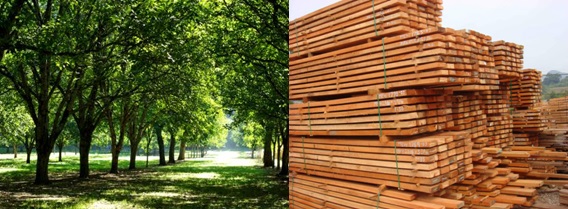Timber vs wood
There is often confusion about the interchangeability of the terms ‘timber’ and ‘wood’.
The term ‘wood’ is used to refer to the substance that makes up the tree. It is the hard, fibrous structural tissue that is commonly found in the stems and roots of trees. The primary function of wood is to support the tree, enabling it to grow straight and tall enough to be able to absorb sunlight for photosynthesis. Wood also enables the transfer of water and nutrients to growing tissues and leaves.
The term ‘timber’ is used to refer to the wood at any stage after the tree has been felled. This can include the raw material, also known as rough timber or the processed material.
In the UK, Australia and New Zealand, as well as some other countries, timber typically refers to sawn wood products that will be used in construction, such as floorboards. 'Timbers' may refer specifically to timber beams or boards used in house building.
In the United States and Canada, timber often refers to felled trees, and the term ‘lumber’ is used to refer to sawn wood products.
What begins with timber in its most basic form can these days result in the most advanced of products.
From the versatility of plywood, the creation of massive glulam beams or even beautifully crafted veneer, engineered wood products provide a varied range of materials that use timber for an increasing list of both structural, functional and design applications.
These products are not only helping to redefine modern construction practices, but show that wood can rival more traditional building products in terms of its environmental impact, strength, cost, finish and workability.
NB See: The use of wood in construction for an alternative definition.
[edit] Related articles on Designing Buildings
- 11 things you didn't know about wood.
- Carpentry.
- Definition of tree for planning purposes.
- Forests.
- Physical Properties of Wood.
- Predicting service life of timber structures.
- Sapwood.
- The differences between hardwood and softwood.
- Timber.
- Tree rights.
- Types of timber.
- Wood around the world.
- Wrot timber.
Featured articles and news
The UK's Modern Industrial Strategy: A 10 year plan
Previous consultation criticism, current key elements and general support with some persisting reservations.
Building Safety Regulator reforms
New roles, new staff and a new fast track service pave the way for a single construction regulator.
Architectural Technologist CPDs and Communications
CIAT CPD… and how you can do it!
Cooling centres and cool spaces
Managing extreme heat in cities by directing the public to places for heat stress relief and water sources.
Winter gardens: A brief history and warm variations
Extending the season with glass in different forms and terms.
Restoring Great Yarmouth's Winter Gardens
Transforming one of the least sustainable constructions imaginable.
Construction Skills Mission Board launch sector drive
Newly formed government and industry collaboration set strategy for recruiting an additional 100,000 construction workers a year.
New Architects Code comes into effect in September 2025
ARB Architects Code of Conduct and Practice available with ongoing consultation regarding guidance.
Welsh Skills Body (Medr) launches ambitious plan
The new skills body brings together funding and regulation of tertiary education and research for the devolved nation.
Paul Gandy FCIOB announced as next CIOB President
Former Tilbury Douglas CEO takes helm.
UK Infrastructure: A 10 Year Strategy. In brief with reactions
With the National Infrastructure and Service Transformation Authority (NISTA).
Ebenezer Howard: inventor of the garden city. Book review.
The Grenfell Tower fire, eight years on
A time to pause and reflect as Dubai tower block fire reported just before anniversary.
Airtightness Topic Guide BSRIA TG 27/2025
Explaining the basics of airtightness, what it is, why it's important, when it's required and how it's carried out.
Construction contract awards hit lowest point of 2025
Plummeting for second consecutive month, intensifying concerns for housing and infrastructure goals.
Understanding Mental Health in the Built Environment 2025
Examining the state of mental health in construction, shedding light on levels of stress, anxiety and depression.























Comments